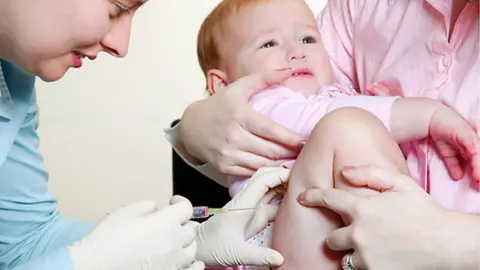Measles cases in Europe tripled last year, WHO says
 Science Photo Library
Science Photo LibraryMeasles cases in Europe tripled between 2017 and 2018 to 82,596 - the highest number recorded this decade, data from the World Health Organization shows.
While vaccination rates are improving, the WHO says coverage is not high enough to prevent circulation of the virus in many countries.
Ukraine reported the highest number of measles cases last year - more than 10 times that of the next highest, Serbia.
Over 90% of cases were in 10 countries, including France, Italy and Greece.
Measles is a highly infectious viral illness that can sometimes lead to serious health complications, including infections of the lungs and brain.
There were 72 deaths from measles in Europe in 2018 compared with 42 in 2017.
The European countries with the highest number of measles cases from January to December 2018 were:
- Ukraine (53,218)
- Serbia (5,076)
- Israel (2,919)
- France (2,913)
- Italy (2,517)
- Russian Federation (2,256)
- Georgia (2,203)
- Greece (2,193)
- Albania (1,466)
- Romania (1,087)
In the UK, there were 953 measles cases last year.
Meanwhile, Ukraine had the highest rate of measles cases in Europe, at 1,209 per one million population - 10 times the country's rate in 2017.
And this largely explains the sharp rise in total cases in Europe, from 25,863 in 2017 to more than 82,000 in 2018.
Vaccination rates for measles, mumps and rubella in Ukraine fell sharply over a number of years during its conflict with Russia, reaching 31% in 2016 - among the lowest in the world.
By the end of 2017, the percentage of children in Ukraine who had been vaccinated had significantly improved, to about 90% but, the WHO says, this now needs to be sustained to protect the population from further outbreaks of measles.
'Gaps at local level'
Dr Zsuzsanna Jakab, WHO regional director for Europe, said: "The picture for 2018 makes it clear that the current pace of progress in raising immunisation rates will be insufficient to stop measles circulation.
"While data indicate exceptionally high immunisation coverage at regional level, they also reflect a record number affected and killed by the disease.
"This means that gaps at local level still offer an open door to the virus."
The WHO says the 2018 surge in measles cases followed a year when European countries achieved their highest ever estimated coverage for the second dose of the measles vaccination - 90%.
The percentage of children receiving the first dose of the vaccine also increased, to 95%.
